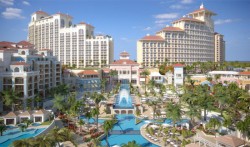Five years after the Ingraham administration granted approvals in principle to three energy companies seeking the green light to construct liquefied natural gas (LNG) terminals in The Bahamas, the Christie government has started negotiating a heads of agreement with the AES Corporation.
The start of the negotiations with the Virginia-based firm signifies that the government has formally decided to approve an LNG project for The Bahamas.
"This administration has decided that of course it will accept the prior administrationメs decision to adopt LNG as a part of our economy," Attorney General Allyson Maynard-Gibson told The Bahama Journal. "In other words, it means that wherever applicants actually satisfy the conditions of our LNG policy we will entertain applications [from] them and possibly enter into heads of agreement with those particular applicants. Weメre now in the process of negotiating a heads of agreement with AES."
Asked whether the government expected to sign the heads of agreement before the present term, she responded, "Oh, absolutely. I do think that. We can never foresee what problems will arise at the moment, but we fully expect that we will be completed well before [the end of this term]."
She revealed that, "The hardcore negotiations have actually been happening for the past few months and weメre very, very pleased with the progress that is ensuing."
AES intends to construct an LNG regasification terminal on Ocean Cay, near Cat Cay and Bimini, and run an LNG pipeline to South Florida to help meet that stateメs growing demand for energy.
But its plan has been delayed by strong objections raised by various interests, including environmentalists and wealthy Cat Cay residents who insist that the project would damage the environment, and even become a terrorist target.
Mrs. Maynard-Gibson said the government is satisfied that it has adequately addressed such concerns.
"The government has made every effort, and is continuing to make every effort to ensure that the appropriate regulatory regime will be in place before any plant is built and operated, and weメre bringing to the table expertise from all over the world who are aware of how LNG plants ought to operate effectively, aware of mistakes that could be made and may perhaps in the past have been made at LNG regasification plants," she said.
"Every effort is being made and we expect everything to go smoothly."
Minister of Agriculture and Marine Resources Leslie Miller, the former trade and industry minister who still has responsibility for LNG, has repeatedly said that LNG is more environmentally friendly than the other fossil fuels used in The Bahamas today.
He has explained that the opportunity to construct an LNG regasification facility has presented itself to The Bahamas due to the increasing demands in South Florida, and the lack of large parcels of land with deepwater access to construct berths to accommodate the tankers.
Minister Miller has also explained that the establishment of an LNG facility in The Bahamas will facilitate the conversion of several electricity-generating plants in the country, which will result in cheaper utility bills for all consumers.
He has also pointed to the benefits of LNG, and its role in diversifying the local economy.
Mrs. Maynard-Gibson too spoke of diversification in her interview with The Bahama Journal on Monday.
"I think that there is the realization that this is something that can contribute to our economy, that can also enable Bahamians to further benefit in terms of science and technology," she said.
"It is not a labour intensive industry by any means, and I think that we will look at benefits to our economy coming from possible transformation of our existing electrical generating plant to LNG, to contributions that will be made by AES toward the School of Science and Technology at the College of The Bahamas, soon to be the University of The Bahamas."
Minister Miller has said an LNG facility will assist with economic diversification by providing income of approximately $25 million per annum for lease and license fees, plus an additional $50 million to $70 million per annum in throughput fees based on current prices and projected demand.
This amount is expected to be supplemented by an additional $500,000 annually which will be contributed to training and environment protection, and community projects.
By: Candia Dames, The Bahama Journal



